#firstchristian
Text
Icon,Saints&Reading: Wed., Sept.16, 2020
Commemorated on September 3_Old Julian Calendar
The Priest Martyr Anthymos, Bishop of Nicomedia, and the Martyrs with him (302)
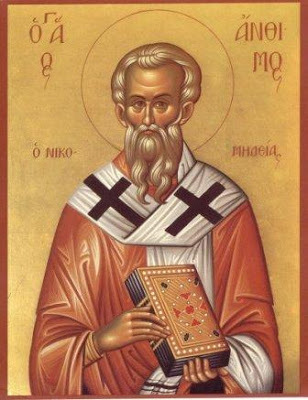
The PriestMartyr Anthymos, Bishop of Nicomedia, and the Martyrs with him suffered during the time of the persecution against Christians under the emperors Diocletian (284-305) and Maximian (284-305). The persecution of Christians became particularly intense after the occurrence of a conflagration at the imperial court at Nicomedia. The pagans accused the Christians of setting the fire and reacted against them with terrible ferocity. Thus, in Nicomedia alone, on the day of the Nativity of Christ, at a church as many as twenty thousand Christians were burned. But this monstrous inhumanity did not frighten off the Christians: they firmly confessed their faith and accepted a martyr's death for Christ. And thus during this period of sufferings died Saints Dorotheus, Mardonius, Migdonius, Peter, Indysos and Gorgonios. One of them was beheaded by the sword, others perished – by burning, or being covered over in the ground or by drowning in the sea. Zinon, a soldier, for his bold denunciation of the emperor Maximian was stoned, and then beheaded. Then also perished at the hands of the pagans the holy Virgin-Martyr Domna – a former pagan-priestess, and also Saint Euthymios, because of their concern that the bodies of the holy martyrs should be buried. Bishop Anthymos, who headed the Nicomedia Church, at the request of his flock concealed himself in a village not far from Nicomedia. From there he sent missives to the Christians, urging them to cleave firmly to the holy faith and not to fear tortures. One of his letters, dispatched with the Deacon Theophilos, was intercepted and given over to the emperor Maximian. Theophilos was subjected to interrogation and died under torture, without revealing to his torturers the whereabouts of Bishop Anthymos. But after a certain while Maximian managed to learn where Saint Anthymos was situated, and he sent a detachment of soldiers after him. The bishop himself met up with them along the way. The soldiers did not recognise the identity of the saint. He invited them to join him and provided them a meal, after which he revealed that he was the one that they were searching for. The soldiers did not know what to do in this instance; indeed, they wanted to leave him be and tell the emperor that they had not found him. Bishop Anthymos was not one to tolerate a lie, and so he would not consent to this. The soldiers themselves came to believe in Christ and accepted holy Baptism. But amidst all this, the saint nonetheless demanded them to carry out the orders of the emperor. When Bishop Anthymos was brought before the emperor, the emperor gave orders that the instruments of execution be brought out and placed before him. "Dost thou think, emperor, to frighten me with these tolls of execution?" – asked the saint. – "No indeed, thou canst not frighten one that doth wish to die for Christ! Execution is frightening only for the cowardly of soul, for whom the present life is most precious". The emperor then directed that the saint be fiercely tortured and beheaded by the sword. Bishop Anthymos to his last gasp with joy glorified God, for Whom he had been vouchsafed to suffer (+ 302; another account of the Nicomedia Martyrs is located under 28 December).
© 1996-2001 by translator Fr. S. Janos.
The Pisidia Icon of the Mother of God
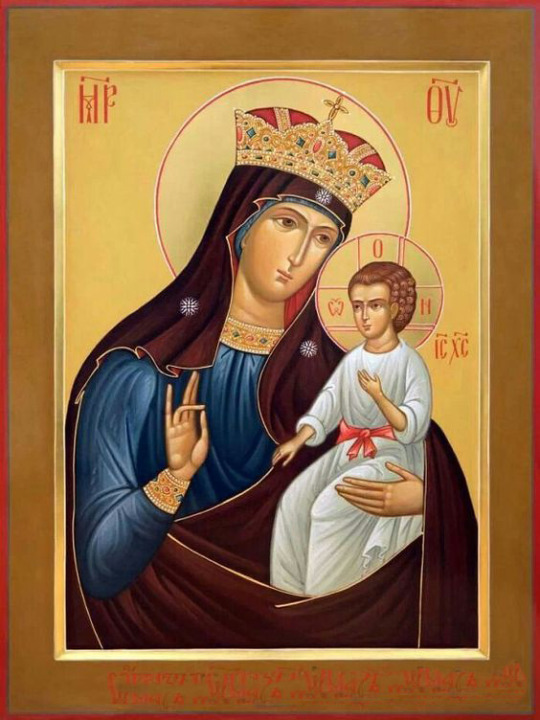
Icon Source
The Pisidia Icon of the Mother of God was glorified by miracles in the city of Sozopolis. The account of its origin is unknown. In the missives about icon-veneration by Germanos, Patriarch of Constantinople, which were read at the Seventh OEcumenical Council, "the icon of the Ever-Immaculate Virgin Mother of God, located at Pisidian Sozopolis and exuding myrh from the hands thereof", is termed "ancient". The miracle-working effected from the icon dates back to the VI Century. One of the miracles was reported by the presbyter Eustathios, who was a contemporary of Patriarch Eutykhios (Comm. 6 April). At Amasea, just off from Sozopolis, there was a certain married couple, for whom children were born dead. Grieving over their misfortune, they turned to Patriarch Eutykhios for advice. Saint Eutykhios made prayer and with the words "in the Name of our Lord Jesus Christ" he anointed them with holy oil from the Cross of the Lord and from the holy icon of the Mother of God. "Name your child Peter, and he wilt be alive", – said he to them. Soon the couple gave birth to a son which they did indeed name Peter, and then they thereafter gave birth to a second son, whom they named John. The people of the city, in learning of this miracle, glorified God. For about 600 years myrh flowed from the Pisidian Icon of the Mother of God, a witness to which was Eleusios (a disciple of the Monk Theodore Sikeotes, of Saisota; Comm. 22 April). A copy in Russia of this ancient wonderworking icon was done in 1608, at the Moscow Novospassk monastery. The Mother of God is depicted with the Divine-Infant on Her left arm, and with Her right hand She gives blessing.
© 1996-2001 by translator Fr. S. Janos.
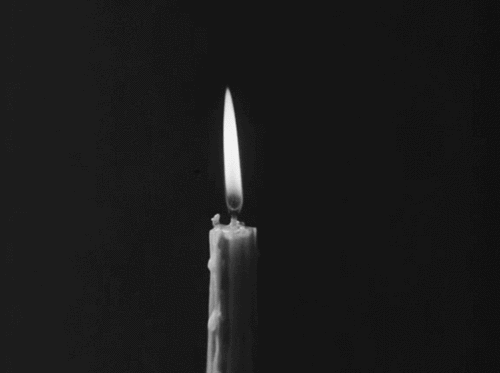
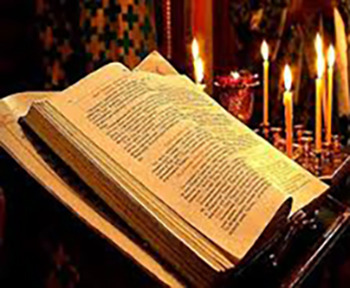
Mark 6:7-13
7And He called the twelve to Himself, and began to send them out two by two, and gave them power over unclean spirits.8He commanded them to take nothing for the journey except a staff-no bag, no bread, no copper in their money belts-9but to wear sandals, and not to put on two tunics.10Also He said to them, "In whatever place you enter a house, stay there till you depart from that place.11And whoever will not receive you nor hear you, when you depart from there, shake off the dust under your feet as a testimony against them. Assuredly, I say to you, it will be more tolerable for Sodom and Gomorrah in the day of judgment than for that cit12So they went out and preached that people should repent.13And they cast out many demons, and anointed with oil many who were sick, and healed them.
Hebrews 13:7-16 (Hieromartyr Anthimus)
7Remember those who rule over you, who have spoken the word of God to you, whose faith follow, considering the outcome of their conduct.8Jesus Christ is the same yesterday, today, and forever.9Do not be carried about with various and strange doctrines. For it is good that the heart be established by grace, not with foods which have not profited those who have been occupied with them.10We have an altar from which those who serve the tabernacle have no right to eat.11For the bodies of those animals, whose blood is brought into the sanctuary by the high priest for sin, are burned outside the camp.12Therefore Jesus also, that He might sanctify the people with His own blood, suffered outside the gate.13Therefore let us go forth to Him, outside the camp, bearing His reproach.14For here we have no continuing city, but we seek the one to come.15Therefore by Him let us continually offer the sacrifice of praise to God, that is, the fruit of our lips, giving thanks to His name.16But do not forget to do good and to share, for with such sacrifices God is well pleased.
#orthodoxy#orthodoxchristian#sprituality#ancient christianity#firstchristian#holyscripture#gospel#sacredtext#wisdom
10 notes
·
View notes
Photo
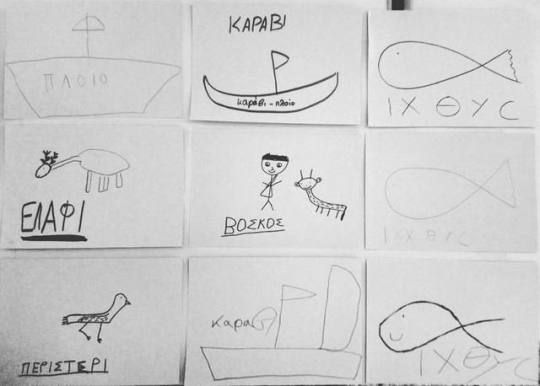
Πρωτοχριστιανικά σύμβολα από τη Γ Δημοτικού στο μάθημα των νέων θρησκευτικών! #patras #patra #ekpaideutiria_anagennisi #ekpaideusi #anagennisi #anagennisiike #sxoleio #school #nipiagwgeio #dimotiko #gymnsio #lykeio #thriskeutika #christians #orthodox #religion #symbol #symbols #draw #firstchristians
#anagennisi#religion#gymnsio#thriskeutika#orthodox#anagennisiike#patra#ekpaideutiria_anagennisi#school#symbols#dimotiko#symbol#patras#christians#firstchristians#lykeio#nipiagwgeio#draw#ekpaideusi#sxoleio
0 notes
Text
Appearance of the Hply Cross Over Jerusalem
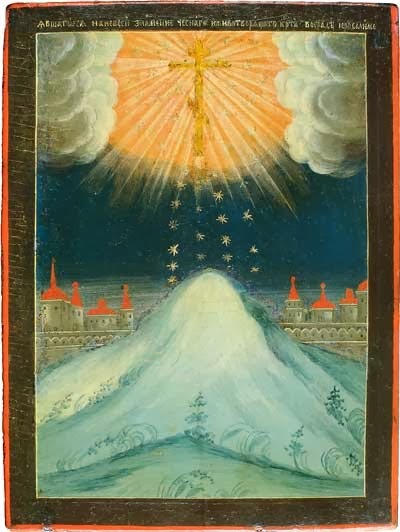
The Precious Cross appeared in the sky over Jerusalem on the morning of May 7, 351 during the reign of the emperor Constantius, the son of Saint Constantine (May 21).
At that time the heresy of Arianism, which taught that Christ was merely a creature and not God, was causing great turmoil and division throughout the Empire. Even after the First Ecumenical Council at Nicea in 325, many people were drawn to this false teaching, and the Orthodox found themselves in the minority in many places.
Constantius, the ruler of the eastern part of the Empire, was a fervent supporter of Arianism. His brothers Constantine II and Constans, who were pious Orthodox Christians, ruled in the west. They were both killed in separate battles around 350, leaving Constantius as sole ruler. Also in 350, Saint Cyril (March 18) became Patriarch of Jerusalem and began his zealous struggle against Arianism.
In May of 351 a luminous Cross appeared over Jerusalem, stretching from Golgotha to the Mount of Olives, a distance of about five and a half miles. The Cross was wide as it was long, and shone more brightly than the sun. Many people left their homes and workplaces to gather in the church and glorify Christ. The historian Sozomen says that this wondrous sign led to the conversion of multitudes of pagans and Jews to Christianity.
A letter from Saint Cyril to the emperor describing this phenomenon, and admonishing him to become Orthodox, has been preserved. The apparition of the Cross remained over the city for a whole week.
The vision of the Cross over Jerusalem strengthened the Orthodox faithful and contributed to the return of many Arians to the Church. It is also a reminder of the awesome Second Coming of Christ, when “the sign of the Son of man shall appear in heaven” (Matthew 24:30).
28 notes
·
View notes
Text
Have a blessed day. Hove above the world by connecting your heart with God and be showered by his blessings.
3 notes
·
View notes
Text
Saints&Reading: Sun, Sept.20, 2020
Commemorated on September 7_”Old” JuIian calendar
Martyr Sozontes (304)

The Martyr Sozontes, a native of Likaonea, was a shepherd. He read the Holy Scriptures attentively, and he loved to share his knowledge about the One God with the shepherds who gathered together with him. He brought many to the faith in Christ and to Baptism. By night-time once, when he sat under an oak tree, he had a vision foretelling his deed of martyrdom for Christ. He set off to the city of Cilician Pompeiopolis, where a festal pagan celebration was being prepared for a golden idol, standing in a pagan temple. Unseen by anyone, saint Sozontes went into the pagan temple and broke off the hand of the idol, and having smashed it he gave the gold to the poor. The missing hands of the idol caused an uproar and commotion in the city: many were under suspicion, given over to interrogation and torture. Not wanting to be the cause ofd suffering for other people, Saint Sozontes went to the emperor Maximian (284-305) and declared, that it was he that broke the hand from the idol. "I did this, – he said, – so that ye might see the lack of power of your god, which offered me no resistance. It is not a god, but rather a deaf and dumb idol. I wanted to smash it all into pieces, so that people would no longer worship its wrought hands". The emperor in a fitful rage commanded that Saint Sozontes be tortured mercilessly. They hung him up and struck at him with iron claws, and then they put on his legs iron shackles with nails inside and took him through the city. After this they again suspended him and beat him with iron rods until his bones broke. In these terrible torments Saint Sozontes gave up his spirit to God (+ c. 304). By decree of the emperor, slaves set a strong fire so as to burn the body of the martyr, but suddenly lightning flashed, it thundered loudly and a strong rain poured down over the flames of the fire. Christians took the body of the martyr by night and gave it over to burial. By his grave and at the place where he had the vision, there occurred healing of many of the sick. A church later was built in memory of the sufferings of the holy martyr.
© 1996-2001 by translator Fr. S. Janos.
Saint John, Archbishop of Novgorod (1186)

Saint John, Archbishop of Novgorod, was born at Novgorod of the pious parents Nikolai and Christina. He passed his childhood in quiet and peaceful surroundings.
After the death of the parents John and his brother Gabriel, having received a small inheritance, decided to make on their inherited property a small monastery in honour of the Annunciation (Blagoveschenie) of the MostHoly Mother of God. At first they built a wooden church, but a short time later built also a stone church. Their good intentions were not without difficulties. Before they finished construction on the stone temple, the brothers totally exhausted their means. Only their steadfast and living faith inspired them to continue what they had started. They turned for help with it to the Queen of Heaven, on Whose account this God-pleasing matter was begun. Through their unflagging prayer She manifested to them Her mercy – She foretold in a dream, that everything necessary for the completion of the temple would be provided. On the following morning the brothers saw a splendid horse, loaded with two sacks of gold. No one came by for it, and when the brothers took hold of the sacks, the horse then vanished. Thus did the Mother of god send means for the monastery.
Upon completion of the monastery construction, – here under the protection of the Mother of God, the brothers took monastic vows. Saint John took the name of Ilia, and Saint Gabriel – the name Gregory.
The chronicles speak about Saint John being made bishop under the entries for the year 1162. His first archpastoral missive was directed to the clergy of his diocese. It was embued with an endearing concern about his flock, written in a spirit of fatherly guidance: "It pleased God and the MostHoly Mother of God, through your prayers, that I but a mere man, should not refrain from this high dignity, of which I am unworthy. Wherein that ye yourselves have encouraged me to this service, now hearken to me..." The saint spoke about the vocation of the pastor – he is concerned about his sheep, he not only chastises but also heals those that lead a sinful life. "At the beginning of my discourse I ask you, be not strongly attached to this world, but rather be instructive to people. Look first of all, that they not give themselves over to strong drunkenness. Yet ye yourselves know, that through this most of all do not only the simple people perish, but we also. When your spiritual children approach you in repentance, then question them with mildness. It is not seemly to impose harsh penances. Scorn not the reading of books, since if we do not make a start of doing this, then what will distinguish us from the simple unschooled people?... Do not impose penances upon orphans.... Let everything be seemly, in that the yoke of Christ ought to be light..."
In the year 1165 Saint John was elevated to archbishop (from that time the Novgorod cathedra became archbishopal).
The winter of 1170 was a very difficult time for Novgorod. Suzdal' forces with their allies laid siege to the city for two days since the Novgorod people would not accept prince Svyatoslav, and likewise the took the tribute-tax of the Dvina district which was not subject to them.
In grief the Novgorod people prayed God and the MostHoly Mother of God for the salvation of the city. On the third night, while he was praying before an image of the Saviour, Saint John heard a voice, ordering him to go to the church of the Saviour on Il'ina street, to take the icon of the MostHoly Mother of God and put it up upon a trident-hook. In the morning the saint told the assembly about the command and sent the archdeacon with clergy to the Sophia church for the icon. Going into the church, the archdeacon bowed down before the icon and wanted to take hold of it, but the icon would not budge. The archdeacon returned to the archbishop and told him about what happened. Then the saint with all the assembly went to the Il'ina church and on their knees began to pray before the icon. They began to sing a molieben canon, and at the 6th ode at the kondak " Mediatrix of Christians" the icon itself moved from the place. The people with tears cried out: "Lord, have mercy!" Then Saint John took the icon and together with two deacons carried it on the trident-hook. The Novgorod people in terror foresaw their doom, since the Suzdal' forces with their allies had made their way ready for pillage. In the sixth hour of the evening there began an assault, and the arrows fell like rain. Then by the Providence of God the icon turned its visage towards the city, and from the eyes of the MostHoly Mother of God there trickled down tears, which the saint gathered on his phelon. A darkness like ashes covered over the Suzdal' forces, they became unable to see and with terror they fell back. This occurred on 25 February 1170. Saint John established in honour of this a solemn feastday for Novgorod – the Sign (Znamenie) of the MostHoly Mother of God (celebrated 27 November).
The Suzdal' army wreaked great harm on the Novgorod region. Here also the archpastor did not remain on the sidelines. He showed fatherly concern about devastated households suffering hunger, and he distributed aid to hapless orphans. Just like other Russian hierarchs, by prayer and by virtue he calmed and soothed the internecine strife in much-suffering Rus'. Thus, in 1172 the archpastor himself journeyed to Vladimir to reconcile the nobleborn prince Andrei Bogoliubsky with the Novgorod people.
The saint not only shared in the adversity of his people, but most of all he concerned himself about their spiritual enlightenment. Saint John devoted great attention to spiritual conversations, which often occurred in the circle of the clergy and the laypeople. There are preserved about 30 of his instructions: concerning Baptism, Confession, the Holy Eucharist. The Guidance for Monks is filled with spiritual grandeur: "Once having followed after Christ, monks as actualisers of spiritual life by the cross ought to live in solitary places, separate from worldly folk. Let them pilfer nothing for themself, nor not wholly be dedicated to God. A monk ought always to be a monk, at every time and at every place – both in sleep and in wakefulness they should preserve the memory of death, and in flesh to be fleshless. Not for everyone does the monastery serve as a doctoring for sensual-love, just as silence – is to anger, and death – to greed for money, and the tomb – to avarice... Monastic life and worldly life are incompatible, – just as they do not harness together a camel and horse. The monk bends his neck beneathe the yoke of the Creator and ought to pull the plow in the valley of humility, in order to multiply the fine wheat by the warmth of the Life-bestowing Spirit and to sow the seed-grains of the reason of God. The black-robed is not his own master; being like gods take care not to rot in likeness to people, nor fall from the heights like the light-bearing prince [i.e. of angels, Lucifer-satan]... for from human glory is begotten haughty pride..."
The saint's spiritual powers of grace were unusual. For his simplicity of soul and purity of heart God gave him power against devils. One time, when the saint as was his custom prayed by night, he heard in the wash-bowl something splashing the water. Seeing that there was no one alongside him, the saint perceived, that this was the doing of a devil trying to scare him. The saint made the sign of the cross over the wash-bowl and restrained the devil. Soon the evil spirit could no longer bear the prayer of the saint, which scorched it with fire, and it began to implore to be released from the wash-bowl. The saint was agreeable, but set a condition, that the devil carry him from Novgorod to Jerusalem to the Sepulchre of the Lord, and back all in one night. The devil fulfilled the command of the saint, but asked him to tell no one about his shaming.
In one of his conversations the saint told his flock, that he knew a man, who by night visited the Holy Land. The revenge of the evil spirit was not slow in coming. It began to scatter about women's things in the cell of the saint. One time when a large crowd of city-folk, stirred up by jealous and unvirtuous people, had gathered at the cell of the monk, the devil appeared to them, looking like a woman which ran out from the cell. The saint came out to the racket and gently asked: "What has happened, my children, what is the noise all about?" The unruly crowd, shouting various charges of perverse life against the saint, dragged him to the River Volkhov. They put the saint on a raft and released it down along the current of the river, reckoning to be rid of it. But the raft, contrary to expectation, sailed against the current straight to the men's Yur'ev monastery, situated three versts from Novgorod. Seeing this, people took shame and with weeping and shouts they went along the river-bank after the raft, beseeching the saint to forgive them and to return to the city. The heart of the simple-souled archpastor was filled with thankful joy, not only for himself but just as much for his flock: ""Lord, hold this not in sin against them!" – he prayed and granted pardon to all.
This occurrence happened not long before the death of the saint. Sensing its approach, he put off the hierarch's omophor and took the schema with the name John, – the same name he had in his youth. As successor to himself he appointed his brother, Sainted Gregory (Comm. 24 May). The saint died on 7 September 1186 and was put in the portico of the Sophia church.
In 1439 through the zeal of Sainted Evphymii repairs were being made at the Sophia cathedral; in the portico chapel-temple of Saint John the Fore-Runner a stone suddenly came loose and powerfully cracked the lid of the tomb standing there. Sainted Evphymii gave orders to lift off the boards broken by the stone, and the temple was filled with fragrance. In the tomb they beheld the undecayed relics of the saint, but no one was able to identify whom this archpastor was. In his cell Sainted Evphymii began fervently to pray God to reveal to him the name of this saint. By night there appeared before him a man, clothed in hierarchical garb, and said that he was Archbishop John, found worthy to serve the miracle of the MostHoly Mother of God in honour of Her Sign (Znamenie). "I proclaim thee the will of God, – continued the saint, – to make the memory of the archbishops and princes lying here, on 4 October, and I shall pray Christ for all Christians". His memory is celebrated likewise with the Assemblage (Sobor) of Novgorod Sainted-hierarchs on 10 February; in 1630 a feastday was also established on 1 December.
© 1996-2001 by translator Fr. S. Janos.


Luke 24:1-12 (4th Matins Gospel)
1Now on the first day of the week, very early in the morning, they, and certain other women with them, came to the tomb bringing the spices which they had prepared.2 But they found the stone rolled away from the tomb.3Then they went in and did not find the body of the Lord Jesus.4 And it happened, as they were greatly perplexed about this, that behold, two men stood by them in shining garments. 5Then, as they were afraid and bowed their faces to the earth, they said to them, "Why do you seek the living among the dead? 6 He is not here, but is risen! Remember how He spoke to you when He was still in Galilee, 7 saying, The Son of Man must be delivered into the hands of sinful men, and be crucified, and the third day rise again.'8 And they remembered His words. 9 Then they returned from the tomb and told all these things to the eleven and to all the rest.10 It was Mary Magdalene, Joanna, Mary the mother of James, and the other women with them, who told these things to the apostles.11 And their words seemed to them like idle tales, and they did not believe them.12 But Peter arose and ran to the tomb; and stooping down, he saw the linen cloths lying by themselves; and he departed, marveling to himself at what had happened.
John 15:17-16:2
17These things I command you, that you love one another.18 if the world hates you, you know that it hated Me before it hated you.19 If you were of the world, the world would love its own. Yet because you are not of the world, but I chose you out of the world, therefore the world hates you. 20 Remember the word that I said to you, 'A servant is not greater than his master.' If they persecuted Me, they will also persecute you. If they kept My word, they will keep yours also.21But all these things they will do to you for My name's sake, because they do not know Him who sent Me.22 If I had not come and spoken to them, they would have no sin, but now they have no excuse for their sin.23 He who hates Me hates My Father also.24 If I had not done among them the works which no one else did, they would have no sin; but now they have seen and also hated both Me and My Father.25 But this happened that the word might be fulfilled which is written in their law, 'They hated Me without a cause.'26 But when the Helper comes, whom I shall send to you from the Father, the Spirit of truth who proceeds from the Father, He will testify of Me.27 And you also will bear witness, because you have been with Me from the beginning.
1These things I have spoken to you, that you should not be made to stumble.2 They will put you out of the synagogues; yes, the time is coming that whoever kills you will think that he offers God service.
Ephesians 6:10-17
10Finally, my brethren, be strong in the Lord and in the power of His might.11 Put on the whole armor of God, that you may be able to stand against the wiles of the devil.12 For we do not wrestle against flesh and blood, but against principalities, against powers, against the rulers of the darkness of this age, against spiritual hosts of wickedness in the heavenly places.13 Therefore take up the whole armor of God, that you may be able to withstand in the evil day, and having done all, to stand.14 Stand therefore, having girded your waist with truth, having put on the breastplate of righteousness,15 and having shod your feet with the preparation of the gospel of peace;16 above all, taking the shield of faith with which you will be able to quench all the fiery darts of the wicked one.17 And take the helmet of salvation, and the sword of the Spirit, which is the word of God;
#orthodox#orthodoxchristianity#ancient christianity#spirituality#holyscripture#gospel#sacredtext#firstchristian
7 notes
·
View notes
Photo

The Pimen Icon of the Most Holy Theotokos was brought to Moscow from Constantinople in 1381 by Metropolitan Pimen. Many miracles took place before this icon, which flowed with a fragrant healing myrrh.
The Pimen Icon was kept in the altar of the Dormition Cathedral in the Kremlin.
17 notes
·
View notes
Text
Women In Christ
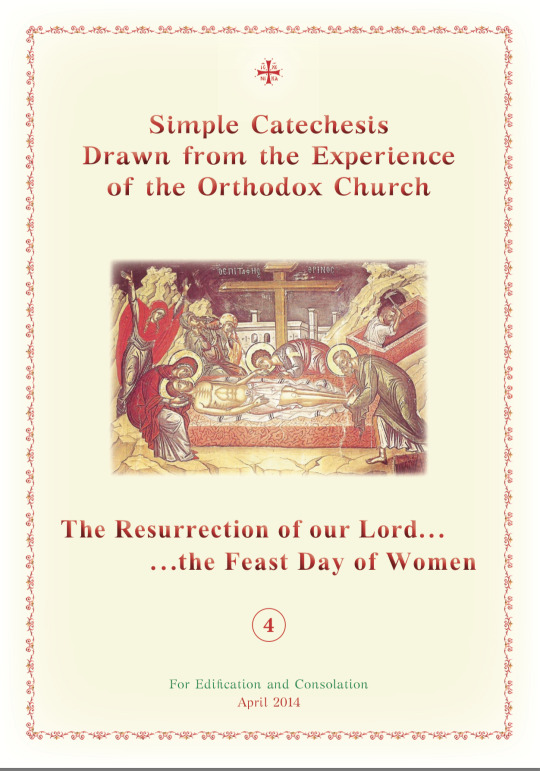
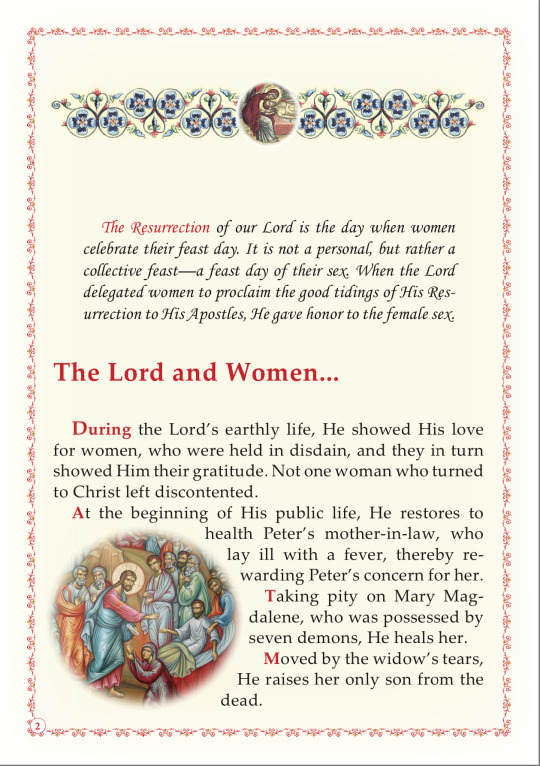
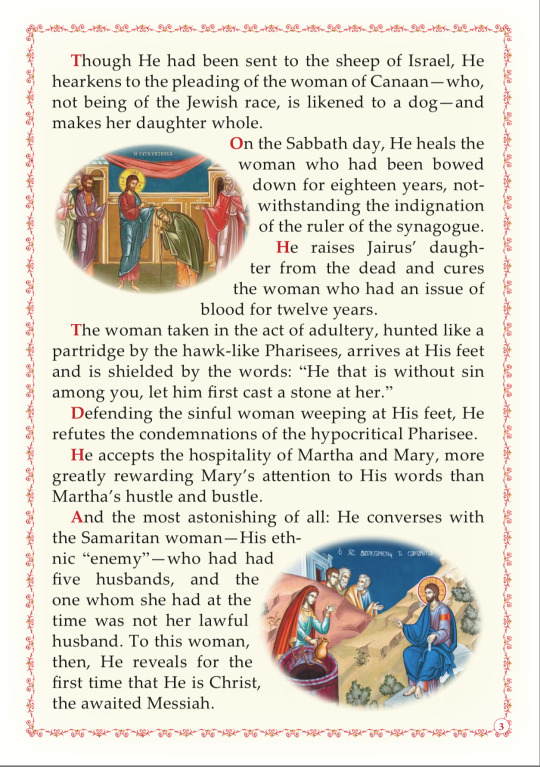



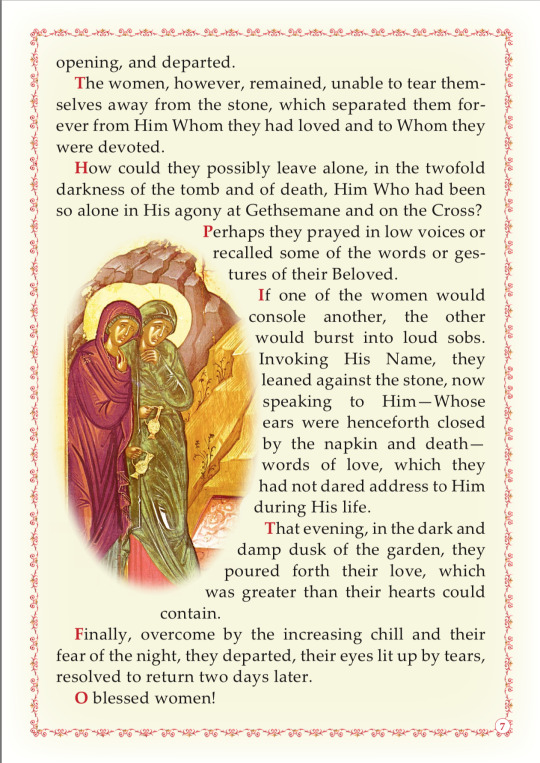

46 notes
·
View notes
Text
Saints&Reading: Thu., Sept.24, 2020
Commemorated on September 11_”Old” Julian Calendar
The Monks Sergei and German of Valaamo ( 1329)
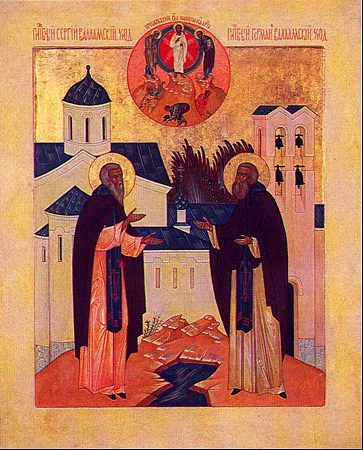
The Monks Sergei and German of Valaamo settled on the island of Valaamo in 1329. The brethren gathered by them shone forth the light of Orthodoxy in this frontier land. The Karelian people began to regard Christianity with renewed suspicion, with its authority in the XIII Century being undermined by the Swedes, who sought to spread Catholicism by means of the sword. The Monks Sergei and German died in about the year 1353. A second commemoration of them is on June 28
© 1996-2001 by translator Fr. S. Janos.
The Nun Theodora of Alexandria

The Nun Theodora of Alexandria and her husband lived in Alexandria. Love and harmony ruled in their family, and this was hateful to the enemy of salvation. Goaded on by the devil, a certain rich man was captivated by the youthful beauty of Theodora and began with all his abilities to lead her into adultery, but for a long time he was unsuccessful. Then he bribed a woman of loose morals, who led the unassuming Theodora astray by saying, that a sin committed in the night God would not account to guilt. Theodora betrayed her husband, but soon came to her senses and realising the seriousness of her downfall, she became furious with herself, incessantly slapping herself on the face and tearing at her hair. Her conscience gave her no peace, and Theodora set out to a reknown hegumeness and told her about her transgression. The hegumeness, beholding the repentance of the young woman, roused in her the faith in Divine forgiveness and reminded her of the Gospel passage about the sinful woman, who with her tears washed the feet of Christ and received from Him forgiveness of her sins. In hope on the mercy of God, Theodora said: "I do believe my God and from hence shall not commit suchlike sin, and I wilt strive to expiate my deed". At that moment Saint Theodora resolved to go off to a monastery, so as to purify herself by deed and by prayer. In secret she left her home, and having attired herself in men's garb, she set off to a men's monastery, since she feared that her husband would manage to find her in a women's monastery. The hegumen of the monastery would not even give blessing to allow her into the courtyard, in testing the resolve of the new-comer. The Nun Theodora spent the night at the gates. In the morning, having fallen down at the knees of the hegumen, she said her name was Theodore from Alexandria and entreated him to let her remain at the monastery for repentance and monastic deeds. Seeing the sincere intent of the new-comer, the hegumen consented.
Even the experienced monks were amazed at the all-night prayers on bended-knee, the humility, the endurance and self-denial of Theodora. The saint asceticised at the monastery for eight years. Her body, once defiled by adultery, became a visible vessel of the grace of God and a receptacle of the Holy Spirit. One time the saint was sent to Alexandria for the buying of bread. Having given blessing for the journey, the hegumen indicated that in case of a stopover along the way, to stay over at the Enata monastery along the way. At the guest-house of the Enata monastery was then staying the daughter of its hegumen, who had come to visit with her father. Allured by the comeliness of the young monk, she tried to seduce the Monk Theodore into the sin of fornication, not knowing that before her was a woman. Being refused, she committed sin with another guest and became pregnant. Meanwhile the saint having bought the bread returned to the home monastery.
After a certain while the father of the shameless girl, realising that a transgression had occurred, began to question his daughter as to who it was that had seduced her. The girl indicated that it was the Monk Theodore. The father at once reported it to the head of the monastery at which Saint Theodora asceticised. The hegumen summoned the saint and told about the accusation. The saint firmly replied: "As God is my witness, I did not do this", and the hegumen, knowing the purity and holiness of life of Theodore, did not believe the accusation. When the girl gave birth, the Enata monks brought the infant to the monastery wherein lived the ascetic, and began to reproach its monks for an unchaste life. But this time even the hegumen believed the slanderous accusation and became angry at the innocent Theodore. They entrusted the infant into the care of the saint and dishonourably threw her out of the monastery. The saint humbly submitted to this new trial, seeing in it the expiation of her former sin. She settled with the child not far from the monastery in an hut. Shepherds out of pity gave her milk for the infant, and the saint herself ate only wild vegetables. Over the course of seven years, bearing her misfortune, the holy ascetic spent in banishment. Finally, at the request of the monks, the hegumen allowed her to return to the monastery together with the child, and in seclusion she spent two years instructing the child. The hegumen of the monastery received a revelation from God that the sin of the Monk Theodore was forgiven. The grace of God dwelt upon the Monk Theodore, and soon all the monks began to witness to the signs, worked through the prayers of the saint. One time in this locale during a time of drought all the water-wells dried up. The hegumen said to the brethren, that only Theodore would be able to reverse the misfortune. Having summoned the saint, the hegumen bid her to bring forth water, and the water in the well afterwards did not dry up. The humble Theodore said, that the miracle was worked through the prayer and faith of the hegumen.
Before her death, the Nun Theodora secluded herself in her cell with the child and in last-wishes bid him to love God, and she asked the compliance of the hegumen and the brethren, to preserve tranquility, to be meek and without malice, to shun obscenity and silliness, to love non-covetousness, and to keep in mind their community life. After this, standing at prayer, for a final time she asked of the Lord forgiveness of her sins. The child also prayed together with her. Soon the words of prayer gave way to death on the lips of the ascetic, and she peacefully expired to an higher world (+ c. 474-491).
The Lord revealed to the hegumen the spiritual accomplishment of the saint and about her concealed secret. The hegumen, in order to remove any disrepute from the deceased, – in the presence of the hegumen and brethren of the Enata monastery, told about his vision and for proof uncovered the bosom of the saint. The Enata hegumen and brethren shrank back in terror at their great transgression, and having fallen down at the body of the saint, with tears they asked forgiveness of the Nun Theodora. News about the Nun Theodora reached her former husband. He took monastic tonsure at this selfsame monastery where his wife had been. And the child, raised by the nun, likewise followed in the footsteps of his foster-mother. Afterwards he became hegumen of this very monastery.
[Trans. Note: One might find highly implausible a beardless monk dwelling in a monastery for so long a period of time unquestioned. But perhaps eunuch-castrates were still common at this time, and as such losing also the capacity to grow beards. The matter of cross-dressing in men's monastic attire is a literary gendre occuring also in the lives of other women saints, usually only for the purposes of concealment and for but a short time. But as the "Redaction" account introducing the Russian original of our text indicates, the Saint-Lives reflect a broad spectrum of historical sources compiled with differing intended purposes, often other than the "modern" penchant for strict recording of historical facts. Which is to say, the account may have been embellished to in entertaining edify both the common man and woman, as well as the sophisticated. Certainly many a Saint-Vita contains an account of a virtually unhurtable and well-nigh unkillable martyr, – so that one is left to wonder that the persecution of Christians by the pagans of old, who in the torturing sometimes themselves dropped down dead, – should have taken so very long, to end. But beneathe any of these embellishments is an actual historical person, who witnessed to Christ our Lord. And to write the miraculous off as mere fable, – is foolish. The spiritual task herein is one of discernment between embellishment and fact.
© 1996-2001 by translator Fr. S. Janos.


Ephesians 1:1-9
1Paul, an apostle of Jesus Christ by the will of God, To the saints who are in Ephesus, and faithful in Christ Jesus:2 Grace to you and peace from God our Father and the Lord Jesus Christ. 3 Blessed be the God and Father of our Lord Jesus Christ, who has blessed us with every spiritual blessing in the heavenly places in Christ, 4 just as He chose us in Him before the foundation of the world, that we should be holy and without blame before Him in love, 5 having predestined us to adoption as sons by Jesus Christ to Himself, according to the good pleasure of His will, 6 to the praise of the glory of His grace, by which He made us accepted in the Beloved.7 In Him we have redemption through His blood, the forgiveness of sins, according to the riches of His grace 8 which He made to abound toward us in all wisdom and prudence, 9 having made known to us the mystery of His will, according to His good pleasure which He purposed in Himself.
Mark 7:24-30
24From there He arose and went to the region of Tyre and Sidon. And He entered a house and wanted no one to know it, but He could not be hidden.25 For a woman whose young daughter had an unclean spirit heard about Him, and she came and fell at His feet. 26 The woman was a Greek, a Syro-Phoenician by birth, and she kept asking Him to cast the demon out of her daughter.27 But Jesus said to her, "Let the children be filled first, for it is not good to take the children's bread and throw it to the little dogs."28 And she answered and said to Him, "Yes, Lord, yet even the little dogs under the table eat from the children's crumbs." 29 Then He said to her, "For this saying go your way; the demon has gone out of your daughter." 30 And when she had come to her house, she found the demon gone out, and her daughter lying on the bed.
#orthodox#orthodox christianity#ancientchristianity#firstchristian#spirituality#gospel#holyscriptures#sacredtexts#wisdom
5 notes
·
View notes
Text

13 notes
·
View notes
Text
Saints&Reading
Commemorated on August 28
Saint Moses the Black of Scete (400)

The Monk Moses Murin the Black lived during the IV Century in Egypt. He was an Ethiopian, and he was black of skin and therefore called "Murin" (meaning "like an Ethiopian"). In his youth he was the slave of an important man, but after he committed a murder, his master banished him, and he joined in with a band of robbers. Because of his mean streak and great physical strength they chose him as their leader. Moses with his band of brigands did many an evil deed – both murders and robberies, so much so that people were afraid even at the mere mention of his name. Moses the brigand spent several years leading suchlike a sinful life, but through the great mercy of God he repented, leaving his band of robbers and going off to one of the wilderness monasteries. And here for a long time he wept, beseeching that they admit him amidst the number of the brethren. The monks were not convinced of the sincerity of his repentance; but the former robber was not to be driven away nor silenced, in demanding that they should accept him. In the monastery the Monk Moses was completely obedient to the hegumen and the brethren, and he poured forth many a tear, bewailing his sinful life. After a certain while the Monk Moses withdrew to a solitary cell, where he spent the time in prayer and the strictest of fasting in a very austere lifestyle. One time 4 of the robbers of his former band descended upon the cell of the Monk Moses and he, not having lost his great physical strength, he tied them all up and taking them over his shoulder, he brought them to the monastery, where he asked of the elders what to do with them. The elders ordered that they be set free. The robbers, learning that they had chanced upon their former ringleader, and that he had dealt kindly with them, – they themselves followed his example: they repented and became monks. And later, when the rest of the band of robbers heard about the repentance of the Monk Moses, then they too gave up their brigandage and became fervent monks.
The Monk Moses did not quickly become free from the passions. He went often to the monastery hegumen, Abba Isidor, seeking advice on how to be delivered from the passions of profligacy. Being experienced in the spiritual struggle, the elder taught him never to overeat of food, to be partly hungry whilst observing the strictest moderation. But the passions would not cease for the Monk Moses in his dreams. Then Abba Isidor taught him the all-night vigil. The monk stood the whole night at prayer, not being on bended knees so as not to drop off to sleep. From his prolonged struggles the Monk Moses fell into despondency, and when there arose thoughts about leaving his solitary cell, Abba Isidor instead strengthened the resolve of his student. In a vision he showed him many a demon in the west, prepared for battle, and in the East a still greater quantity of holy Angels, likewise readied for fighting. Abba Isidor explained to the Monk Moses, that the power of the Angels would prevail over the power of the demons, and in the long struggle with the passions it was necessary for him to become completely cleansed of his former sins.
The Monk Moses undertook a new effort. Making the rounds by night of the wilderness cells, he carried water from the well to each brother. He did this especially for the elders, who lived far off from the well and who were not easily able to carry their own water. One time, kneeling over the well, the Monk Moses felt a powerful blow upon his back and he fell down at the well like one dead, laying there in that position until dawn. Thus did the devils take revenge upon the monk for his victory over them. In the morning the brethren carried him to his cell, and he lay there a whole year crippled up. Having recovered, the monk with firm resolve confessed to the hegumen, that he would continue to asceticise. But the Lord Himself put limits to this struggle of many years: Abba Isidor blessed his student and said to him, that the profligate passions had already gone from him. The elder commanded him to commune the Holy Mysteries and in peace to go to his own cell. And from that time the Monk Moses received from the Lord the power over demons.
Accounts about his exploits spread amongst the monks and even beyond the bounds of the wilderness. The governor of the land wanted to see the saint. Having learned about this, the Monk Moses decided to hide away from any visitors and he departed his own cell. Along the way he met up with servants of the governor, who asked him, how to get to the cell of the wilderness-dweller Moses. The monk answered them: "Go on no further to this false and unworthy monk". The servants returned to the monastery, where the governor was waiting, and they conveyed to him the words of the elder they had chanced upon. The brethren, hearing a description of the elder's appearance, all as one acknowledged that they had come upon the Monk Moses himself.
Having spent many a year at monastic exploits, the Monk Moses was ordained deacon. The bishop attired him in white vesture and said: "Abba Moses is now entirely white". The saint answered: "Vladyka, what makes it purely white – the outer or the inner?" Through humility the saint reckoned himself unworthy to accept the dignity of deacon. One time the bishop decided to test him and he bid the clergy to drive him out of the altar, whilst reviling him for being an unworthy black-Ethiopian. With full humility the monk accepted the abuse. Having put him to the test, the bishop then ordained the monk to be presbyter. And in this dignity the Monk Moses asceticised for 15 years and gathered round himself 75 disciples.
When the monk reached age 75, he forewarned his monks, that soon brigands would descend upon the skete and murder all that were there. The saint blessed his monks to leave in good time, so as to avoid the violent death, His disciples began to beseech the monk to leave together with them, but he replied: "I many a year already have awaited the time, when upon me there should be fulfilled the words which my Master, the Lord Jesus Christ, did speak: "All, who take up the sword, shalt perish by the sword" (Mt. 26: 52). After this seven of the brethren remained with the monk, and one of these hid not far off during the coming of the robbers, The robbers killed the Monk Moses and the six monks that remained with him. Their death occurred in about the year 400.
© 1996-2001 by translator Fr. S. Janos.
The Great Martyr Shushanika, Princess of Rana (475)(Susanna of Georgia)
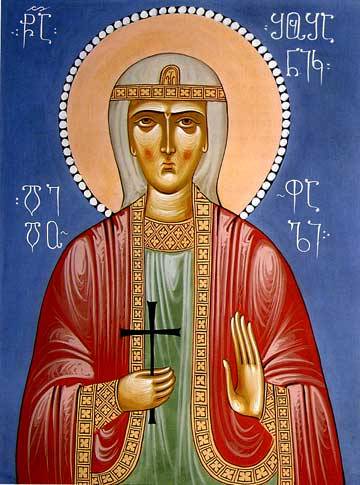
The GreatMartyress Shushanika, Princess of Rana (+ 475), was the daughter of the reknown Armenian military-commander Vardanes. Her actual name – was Vardandukht, but the name she was fond of using – was Shushanika. From her childhood years Saint Shushanika distinguished herself by her fear of God and her piety.
She entered into marriage with the pitiakhshah (governor of outlying districts of Gruzia) named Varxenes, who renounced Christ and became an apostate to the faith. In the eighth year of the rule of the shah Peroz, Varxenes set off to Kteziphon, whereat was the residence of the Persian shah, and he became a Mazdaeite (fire-worshipper), so as to please the shah. Having learned about this upon the return of her husband, Saint Shushanika did not want to continue married life with an apostate from God. She left the palace and began to live in a small cell, not far off from the palace church. The priest of the empress, named Yakov-James Tsurtaveli (afterwards the author of her vita), relates that the holy empress, learning of her husband's intent to resort to force, was filled with determination to stand firmly in the faith, despite any sort of entreaties, threats or tortures. Rejecting the offers of Varxenes, on 8 January 469 she was subjected to a beating by him and thrown into chains, and on 14 April 469 she was locked up in a prison fortress, where she remained for six and an half years. "Six years she spent imprisoned and yet adorned with virtues: by fasting, by vigilance, standing on her feet, with unflagging prostrations and the incessant reading of books. She was wrought into a spiritual flute, sanctified and embellished by prison". To the prison came many of the afflicted, "and each, through the prayers of Blessed Shushanika, received from God the Lover-of-Mankind that in which they were in need of: the childless – children, the sick – health, the blind – sight". By this time Varxenes had converted to fire-worship the children of Saint Shushanika, and they ceased to visit their imprisoned mother. In the seventh year of the imprisonment of Saint Shushanika sores began to appear on her legs and body. Jodjik, the brother of the pitiakhshah Varxenes, having learned that Blessed Shushanika was close to death, managed to get into the prison with his wife and children and he besought of Saint Shushanika: "Forgive us our guilt and bless us". Saint Shushanika forgave them and blessed them, saying: "All the present life is transient and inconstant, like a flower of the fields; one plants it, and another is pleased, one squanders it on trivia while another doth gather, one uses it for oneself, but another doth find...".
On the eve of the blessed death of the holy martyress, she was visited in prison by the Gruzia Katholikos-Archbishop Samuel I (474-502), by Bishop John and by the priest of the martyress Yakov-James Tsurtaveli (over the course of all six years he had constantly visited and consoled her). The court bishop Athots (Photios) communed Saint Shushanika. Her last words were: "Blest be the Lord my God, wherefore with peace I do repose and sleep". The end of the blessed martyress ensued on 17 October, on the feastday of the Unmercenary Martyrs Cosmas and Damian, and it was particularly on this day that the ancient Church celebrated her memory.
The relics of the holy Martyress Shushanika rested at first in a church in the city of Tsortag. The Tsortag church after a certain while fell under the lead of an Armenian bishop – a Monophysite, and the Katholikos-Archbishop of Gruzia Samuel IV (582-591) transferred the holy relics of Saint Shushanika to the city of Tbilisi, where in the year 586 they were put into a chapel of the Metekh church, on the south side of the altar. And indeed, it is in connection with this event that the memory of Saint Shushanika was transferred from 17 October to 28 August.
© 1996-2001 by translator Fr. S. Janos.
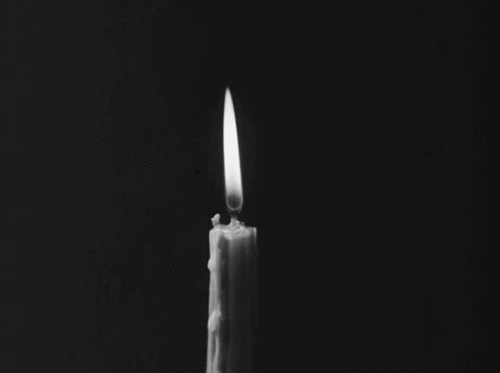

Mark 5:1-20
1Then they came to the other side of the sea, to the country of the Gadarenes. 2And when He had come out of the boat, immediately there met Him out of the tombs a man with an unclean spirit,3who had his dwelling among the tombs; and no one could bind him, not even with chains,4because he had often been bound with shackles and chains. And the chains had been pulled apart by him, and the shackles broken in pieces; neither could anyone tame him.5And always, night and day, he was in the mountains and in the tombs, crying out and cutting himself with stones./6When he saw Jesus from afar, he ran and worshiped Him.7And he cried out with a loud voice and said, "What have I to do with You, Jesus, Son of the Most High God? I implore You by God that You do not torment me."8For He said to him, "Come out of the man, unclean spirit!"9Then He asked him, "What is your name?" And he answered, saying, "My name is Legion; for we are many."10Also he begged Him earnestly that He would not send them out of the country.11Now a large herd of swine was feeding there near the mountains.12So all the demons begged Him, saying, "Send us to the swine, that we may enter them."13And at once Jesus gave them permission. Then the unclean spirits went out and entered the swine (there were about two thousand); and the herd ran violently down the steep place into the sea, and drowned in the sea.14So those who fed the swine fled, and they told it in the city and in the country. And they went out to see what it was that had happened.15Then they came to Jesus, and saw the one who had been demon-possessed and had the legion, sitting and clothed and in his right mind. And they were afraid.16And those who saw it told them how it happened to him who had been demon-possessed, and about the swine.17Then they began to plead with Him to depart from their region.18And when He got into the boat, he who had been demon-possessed begged Him that he might be with Him.19However, Jesus did not permit him, but said to him, "Go home to your friends, and tell them what great things the Lord has done for you, and how He has had compassion on you."20And he departed and began to proclaim in Decapolis all that Jesus had done for him; and all marveled.
#orthodoxy#orthodoxchristianity#ancientchristianity#firstchristian#holyscripture#gospel#spirituality
5 notes
·
View notes
Photo

13 notes
·
View notes
Video
youtube
The Troparion of Pentecost (English, Greek, and Arabic)
#pentecost#orthodoxy#orthodoxchristianity#sacredmusic#sacredchants#firstchristian#ancientfaith#feast#mysticalchristianity
12 notes
·
View notes
Link
#orthodoxy#orthodoxchristian#firstchristian#spirituality#feast#assumption#dormition#motherofgod#theotokos#virginmary
6 notes
·
View notes
Text
Saints&Reading: Sat., Sept. 12, 2020
Commemorated on August 30, November 23_Old Julian Calendar
The Holy NobleBorn Prince Alexander Nevsky( 1263)
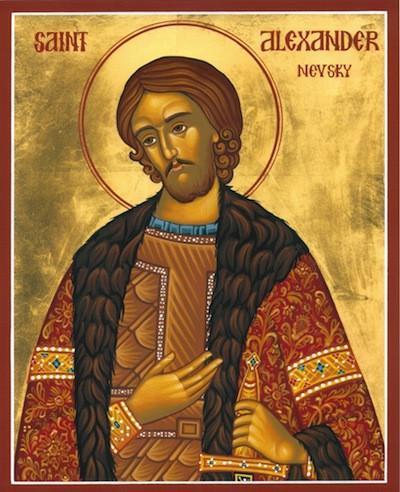
The Holy NobleBorn Prince Alexander Nevsky (in monastic-schema Alexei) died on the return journey from the Horde at Gorodtsa on the Volga, on 14 November 1263, and on 23 November (under this day is located the account about him) in 1263 he was buried in the Cathedral Church of the Nativity Monastery in the city of Vladimir (there is set up there now a memorial to the holy prince; yet another memorial is set up in the city of Pereslavl'-Zalessk). Veneration of the nobleborn prince started right at his burial, whereof was a remarkable miracle: the saint himself extended his hand for the absolving prayer. Great Prince Ioann Ioannovich (1353-1359) in his spiritual testament written in the year 1356, left to his son Dimitrii (1363-1389), the future victor of the Battle of Kulikovo, "an icon of Saint Alexander". The undecayed relics of the nobleborn prince were opened, on account of a vision, before the Kulikovo Battle – in the year 1380, and then were set forth for local feast-celebration. For the prayers of the holy prince, glorified by defense of the Fatherland, Russian commanders resorted to in all the following times. On 30 August 1721 Peter I, after a lengthy and exhausting war with the Swedes, concluded the Nishtad Peace. This day was decided upon to hallow by the transfer of the relics of the NobleBorn Prince Alexander Nevsky from Vladimir to the new northern capital, Peterburg, arranged on the banks of the Neva. Withdrawn from Vladimir on 11 August 1723, the holy relics were greeted at Shlissel'burg on 20 September of that year and remained there until 1724, when on 30 August they were placed in the Trinity Cathedral of the Alexander Nevsky Lavra (Monastery), where now also they rest. By an edict/ukaz on 2 September 1724 there was established a feastday on 30 August (in 1727 the feast was discontinued by reason of non-church matters, and involved clique-struggles at the imperial court. In 1730 the feast was again re-established).
Archimandrite Gavriel Buzhinsky (later Bishop of Riazan, + 27 April 1731) compiled a special service in remembrance of the Nishtad Peace, combining with it a service to Saint Alexander Nevsky.
The name of the Defender of the borders of Russia and the Patron of Soldiers is famous far from the regions of our Native Land. The testimony to this: the numerous temples dedicated to Saint Alexander Nevsky. The most famous of them: the Patriarchal Cathedral at Sofia, the Cathedral church in Talinin, and a church in Tbilisi. These churches are a pledge of friendship of the Russian National-Liberator with brother nations.
© 1996-2001 by translator Fr. S. Janos.
NobleBorn Prince Daniel of Moscow (1652)
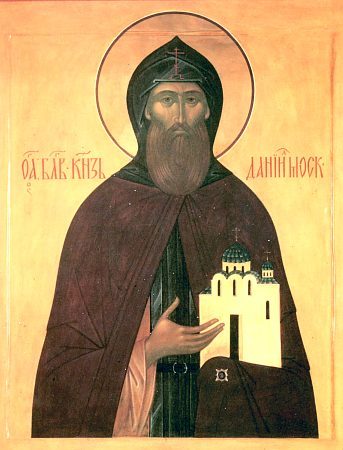
Holy Nobleborn Prince Daniel (Daniil) of Moscow was born at Vladimir in the year 1261. He was the fourth son of Saint Alexander Nevsky (Comm. 30 August and 23 November) and Righteous Vassa. Two years after birth he lost his father. The date of his mother's repose is not indicated in the chronicles; it is known only, that she was buried in the church in honour of the Nativity of Christ at the Vladimir Uspenie monastery (the Princess monastery), and the people in the surroundings venerated her as "Righteous" ("Pravedna").
In 1272 holy Prince Daniel received as his allotted portion the city of Moscow with its adjacent lands. The holy prince built on the banks of the River Moskva (Moscow) a church (and alongside it a monastery) in honour of his same-name patron saint, the Monk Daniel the Pillar-Dweller (Comm. 11 December). The Moscow principality was during this period small and unobtrusive. While growing up, holy Prince Daniel strengthened and expanded it, not in manners unjust or coercive, but instead benevolent and peace-loving. In Rus' it was a time of unrest. Fratricidal strife amongst the appanage princes was rife. And often, thanks to holy Prince Daniel, and his incessant striving for unity and peace in the Russian Land, bloodshed was averted. In 1293 his brother, the Great-prince Alexander Alexandrovich, together with Tatars summoned from the Horde and headed by Diuden ("the Diudenev Host"), laid waste to Russian cities: Murom, Suzdal', Kolomna, Dmitrov, Mozhaisk, Tver'. Prince Daniel decided to adjoin them to Moscow, to save their people from perishing. There was not the strength for resistance. Together with his people, the prince braced himself for terrible destruction and pillaging. Standing up for his rights, Saint Daniel was compelled to come out against his brother near a place, called Yur'evo Tolchische ("Yur'evo Threshing-Mill"), but here also the yearning for peace won out in him, and bloodshed was averted.
In 1300, when the Ryazan prince Konstantin Romanovich, having summoned Tatars to his aid, was occupied in secret preparations for a sudden assault on the lands of the Moscow principality, Prince Daniel went with an army to Ryazan, and beating the enemy, he took captive Konstantin and destroyed a multitude of Tatars. This was a first victory over the Tatars, though not a tremendous victory, but it was noteworthy nonetheless – as a first push towards freedom. Having beaten the Ryazan prince and scattered his confederates the Tatars, holy Prince Daniel did not take advantage of his victory to seize foreign lands or take booty, as was the accepted custom during these times, but rather he displayed an example of true non-covetousness, love and fraternity. The holy prince never resorted to arms to seize the lands of others, nor did he ever snatch away the property of other princes either by force or by treachery. And for this the Lord saw fit to expand the boundaries of his princely realm. Ioann Dimitrievich, prince of Pereslavl'-Zalessk, a nephew of Daniel, was gentle and pious and benevolent towards the poor, and he esteemed and loved his uncle; dying childless in 1302, he bequeathed his principality to Saint Daniel. The Pereslavlsk lands together with Dmitrov were, after Rostov, foremost in number of inhabitants, with corresponding fortification befitting a major city. Pereslavl'-Zalessk was well protected on all sides. But the holy prince remained faithful to Moscow and did not transfer the capital of his princedom to the stronger and more significant seat of the Pereslavl' of this period. This annexation moved Moscow up to be numbered as the most significant principality. And here was set in place the principle of the unification of the Russian Land into a single powerful realm.
How wondrous over the expanse of ages was clearly manifest the Providential Will of God concerning the Russian Land and its destiny!
Grateful in remembrance of the constant Blessing of the Hodegetria ("Way-Guide Mother of God) both in his personal life, and also in the life of the Russian realm, Saint Daniel's father – Saint Alexander Nevsky, had expressed it in the words: "God is not in might, but in right!".
In 1303 Saint Daniel fell seriously ill. He assumed the monastic great-schema and commanded that he be buried at the Danilov monastery. Through deep humility he wanted to be buried not within the church, but in the common monastery cemetery. The holy prince died on 4 March.
Within the passage of less than 30 years after the repose of holy Prince Daniel, the Danilov monastery founded by him was transformed into the Moscow Kremlin, the church was transformed into a parish church, and the cemetery became non-monastic. During the time of Great-prince Ivan III (1462-1505), the Monk-prince Daniel gave reminders of himself to his forgetful descendents. As a stranger he appeared to a youth attendant on the great-prince and said: "Be not afraid of me – I was a Christian and the master of this place, my name is Daniel Prince of Moscow, and by the will of God I am here. Tell about me to Great-prince Ioann (Ivan) saying: thou delightest thyself while yet having forgotten me, but God hath not forgotten me". And after this it was that the great-prince established the singing of cathedral panikhidas for his ancestral princes. During the time tsar Ivan the Terrible, at the grave of Saint Daniel was healed the dying son of a barge merchant. The tsar, struck by the miracle, renovated the ancient Danilov monastery and established a yearly church procession, made by the metropolitan to the place of burial of the holy prince, serving there a panikhida.
In 1652 holy Monk-prince Daniel was glorified with the uncovering of his incorrupt relics, which on 30 August were transferred to the church in honour of the Holy Fathers of the Seventh OEcumenical Council.
The holy relics were placed in a reliquary "to the glorifying of the Holy Trinity and for the healing of the infirm". The Moscow metropolitan Platon (+ 1812), in the Vita of the holy prince compiled by him, writes: "This original founder laid the foundation of present-day majestic Moscow, going about this with quiet steps upon a small foot-path. And thus as with any edifice, built not with extreme haste but the rather instead with great artifice and skill, doth receive a particular solidity and doth stand indestructible for a long time; and just as a tall tree growing for many a century, and having started first of all with a small sprout, and thickeneth little by little, with its branches spreading about far around, so also was it needful for this city to grow from the small, but solid root, in order that its first glimmer not beshadow the eyes of the envious, and that initially it not be disturbed or felled early on, but rather grow up to its true height. Thus did this founder prepare the great city given him; though small, but shining uninterrupted by any wafting of the wind, he did bequeathe the great glory of its rise to his son Great-prince Ioann (Ivan) Danilovich, called Kalita".
© 1996-2001 by translator Fr. S. Janos.
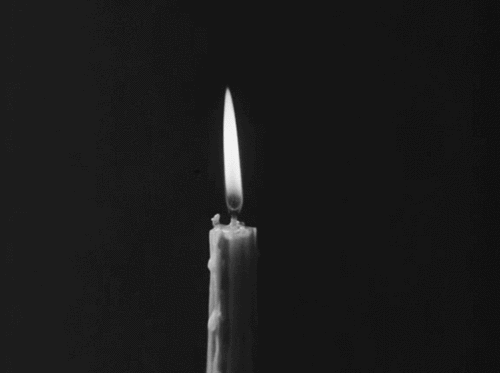

Matthew 23:1-12
1Then Jesus spoke to the multitudes and to His disciples,2saying: "The scribes and the Pharisees sit in Moses' seat.3Therefore whatever they tell you to observe, that observe and do, but do not do according to their works; for they say, and do not do.4For they bind heavy burdens, hard to bear, and lay them on men's shoulders; but they themselves will not move them with one of their fingers.5But all their works they do to be seen by men. They make their phylacteries broad and enlarge the borders of their garments.6They love the best places at feasts, the best seats in the synagogues,7greetings in the marketplaces, and to be called by men, 'Rabbi, Rabbi.'8But you, do not be called 'Rabbi'; for One is your Teacher, the Christ, and you are all brethren.9Do not call anyone on earth your father; for One is your Father, He who is in heaven.10And do not be called teachers; for One is your Teacher, the Christ.11But he who is greatest among you shall be your servant.12And whoever exalts himself will be humbled, and he who humbles himself will be exalted.
Galatians 5:22-6:2 (St. Alexander Nevsky)
22But the fruit of the Spirit is love, joy, peace, longsuffering, kindness, goodness, faithfulness,23gentleness, self-control. Against such there is no law.24And those who are Christ's have crucified the flesh with its passions and desires.25If we live in the Spirit, let us also walk in the Spirit.26Let us not become conceited, provoking one another, envying one another.
1Brethren, if a man is overtaken in any trespass, you who are spiritual restore such a one in a spirit of gentleness, considering yourself lest you also be tempted.2Bear one another's burdens, and so fulfill the law of Christ.
4 notes
·
View notes
Text
Saints&Reading: Tue., Aug. 18, 2020
Commemorated on August 5_Julian Calendar
The Martyr Pontius (267)
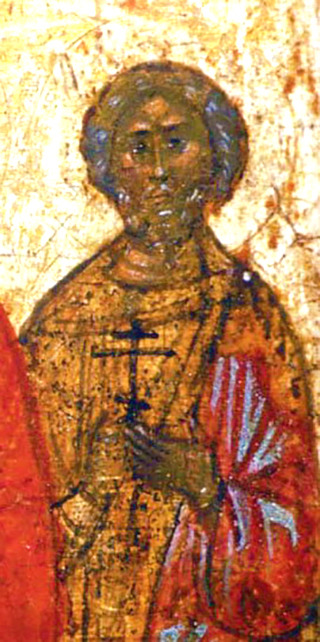
The Martyr Pontius lived during the III Century, the son of a pagan Roman senator named Marcus and his wife Julia. While with child, Julia had gone with her husband to the pagan temple of Jupiter. The devil, inhabiting the temple, shouted from the lips of the pagan priest that the boy in Julia's womb would destroy Jupiter and his pagan temple. When the boy was born, his mother wanted to kill him out of fear of the prediction, but his father opposed this and the child was left to live. He was named Pontius, and he grew up sharp of mind and keen for study. On his way to the pagan school Pontius happened to go past an house, where Christians were making the morning Divine-services. Hearing the words of the psalm which the Christians were singing: "pagan idols be silver and gold, the works of the hands of men..." (Ps. 113: 12 [115: 4]). Pontius became very interested in this verse and he paused at the gate. Pope Pontian, who was making the service, invited Pontius and his companion Valerian to come in. After the service, the pope talked for a long while with the youths, revealing to them the Gospel teachings, and after a certain while he baptised them. Saint Pontius in turn likewise converted his father to Christ, whom Pope Pontian also baptised, together with his whole household. And after the death of his father, Saint Pontius, then 20 years old, was appointed by the emperor Alexander Severus (222-235) as a senator, to take the place of his deceased father. In the Senate and the surroundings of the emperor, Saint Pontius enjoyed universal esteem for his good nature, sound sense and fairness. Under the successor to the emperor Alexander Severus – Maximian (235-238), Pope Saint Pontian finished his life as a martyr (+ 235).
Pope Saint Antherus was elected Bishop of Rome in place of Pope Saint Pontian, and he too soon accepted suffering and death for Christ (+ 236). His successor was Pope Saint Fabian (Fabius), who as a presbyter fearlessly gave burial to the bodies of martyrs. Pope Saint Fabian loved Saint Pontius as though he were his own flesh and blood son. Saint Pontius distributed with Saint Fabian all his substance on the needs of the poor. After the perishing of impious Maximian, the new emperor Gordian (238-244) did not persecute Christians, and thereafter in turn the emperor Philip (244-249) together with his co-regent son Philip was persuaded by the conversations and preaching of Saint Pontius to believe in Christ and to accept Baptism from holy Pope Fabian. With the permission of the emperors, Saints Pontius and Fabian threw down the statue of Jupiter at the pagan temple and on this place built a church. For 4 years the Church of Christ dwelt in peace and tranquility. But then Decius (249-251) ascended the throne, having organised a rebellion and murdered the emperor Philip and his son. And during this time Sainted Fabian, Pope of Rome (+ 250), accepted death for Christ. But Saint Pontius left Rome for the city of Cimelum (on the border of Italy and Gaul-France) and lived there like a stranger. During the time of the emperor Valerian (253-259), cruel torturers were sent out with full authority to all ends to seek out and kill all Christians. And thus Claudius and Anubius arrived in the city of Cimelum for this purpose. Saint Pontius fearlessly confessed himself a Christian and refused to offer sacrifice to idols. They shackled him in irons and threw him in prison. From the very beginning of the torture the saint calmly admonished the torturers, that the Lord would bring to naught the torture and they would see the power of God. And indeed, as soon as the servants attempted to tie Saint Pontius to the rack, it fell apart to pieces, and the torturers fell to the ground as though dead.
"Be convinced, O man of little faith, in the power of my Lord", – said Saint Pontius to Claudius, but on the advice of Anubius he gave Saint Pontius over to be devoured by two bears in the circus. The wild beasts, while not touching the saint, fell instead upon their keepers and tore at them. The spectators began to shout: "God only is the Christian God, in Whom believeth Pontius". By order of the torturers a bon-fire was built, but it burnt out, and the saint remained alive, and even his clothes did not burn. The crowd shouted all the more strongly: "Great is the God of the Christians!" Saint Pontius then was sentenced to beheading by the sword, and the execution was made out beyond the city in the year 257. The body of Saint Pontius was given burial at the place of execution by his comrade and friend Valerian.
© 1996-2001 by translator Fr. S. Janos.
Martyr Eusignios of Antioch (362)
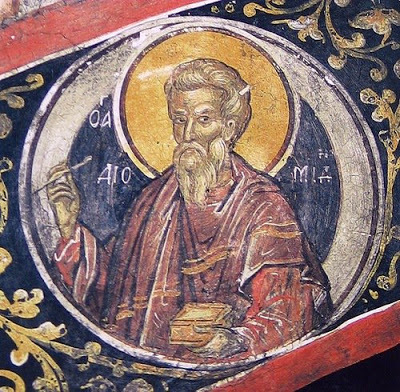
The Martyr Eusignios was born at Antioch in the mid III Century. Over the course of sixty years he served in the Roman armies of the emperors Diocletian, Maximian Hercules, Constantius Chlorus, Constantine the Great and his sons. Saint Eusignios was a companion of Saint Basiliskos (Comm. 3 March and 22 May), and he provided an account of his deed of martyrdom (+ c. 308). At the beginning of the reign of Saint Constantine the Great, Saint Eusignios was a witness to the appearance in the sky of the starry Cross, a prediction of victory. Saint Eusignios retired in his old age from military service and returned to his own country. There he spent his time in prayer, fasting, and attending the temple of God. And thus he lived until the reign of Julian the Apostate (361-363), who yearned for a return to paganism. Through the denunciation of one of the Antioch citizens, Saint Eusignios stood trial as a Christian before the emperor Julian in the year 362. He fearlessly accused the emperor of apostacy from Christ, and reproached him with the example of his relative, Constantine the Great, and he described in detail how he himself had been an eyewitness to the appearance in the sky of the sign of the Cross. Julian did not spare the quite old Saint Eusignios, then 110 years old, but rather ordered him beheaded.
© 1996-2001 by translator Fr. S. Janos.
2 Corinthians 2:14-3:3
14Now thanks be to God who always leads us in triumph in Christ, and through us diffuses the fragrance of His knowledge in every place.15For we are to God the fragrance of Christ among those who are being saved and among those who are perishing.16To the one we are the aroma of death leading to death, and to the other the aroma of life leading to life. And who is sufficient for these things? 17For we are not, as so many, peddling the word of God; but as of sincerity, but as from God, we speak in the sight of God in Christ.
1Do we begin again to commend ourselves? Or do we need, as some others, epistles of commendation to you or letters of commendation from you? 2You are our epistle written in our hearts, known and read by all men; 3clearly you are an epistle of Christ, ministered by us, written not with ink but by the Spirit of the living God, not on tablets of stone but on tablets of flesh, that is, of the heart.
Matthew 23:29-39
29Woe to you, scribes and Pharisees, hypocrites! Because you build the tombs of the prophets and adorn the monuments of the righteous,30and say, 'If we had lived in the days of our fathers, we would not have been partakers with them in the blood of the prophets.'31Therefore you are witnesses against yourselves that you are sons of those who murdered the prophets.32Fill up, then, the measure of your fathers' guilt.33Serpents, brood of vipers! How can you escape the condemnation of hell?34Therefore, indeed, I send you prophets, wise men, and scribes: some of them you will kill and crucify, and some of them you will scourge in your synagogues and persecute from city to city,35that on you may come all the righteous blood shed on the earth, from the blood of righteous Abel to the blood of Zechariah, son of Berechiah, whom you murdered between the temple and the altar.36Assuredly, I say to you, all these things will come upon this generation.37O Jerusalem, Jerusalem, the one who kills the prophets and stones those who are sent to her! How often I wanted to gather your children together, as a hen gathers her chicks under her wings, but you were not willing!38See! Your house is left to you desolate;39for I say to you, you shall see Me no more till you say, 'Blessed is He who comes in the name of the LORD!'
#orthodoxy#orthodoxchristianity#ancientfaith#firstchristian#spirituality#sacredtext#gospel#scripture
5 notes
·
View notes